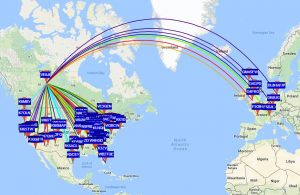Weak Signal work with WSPR
WSPR is a QRP mode that can be setup quickly with most transceivers. The bands in use are from 630 m to 70 cm and above. Each band has a designated WSPR center with a passband of 200 hz. The message that is transmitted consists only of you call and maidenhead locator eg. VE6JI DO46gs. The receiving station shows your call, locator, frequency drift in hz/min, and time offset. The decode nature of WSPR requires that both the sender & receiver have clocks that are synchronized very closely to the atomic standard.
Once the signals of the receiving station have been decoded, they are then posted to WSPRnet. WSPR transmissions are often the weakest transmissions at 5w and less. This opens up a QRPr world to amateurs using non-standard transmitters & receivers. Reception and reporting can be accomplished using $20 SDR dongles and a random length of wire. Transmission can be accomplished with homebrewed equipment using a Raspberry Pi and a 100 mw ssb transmitter. Design considerations should include frequency stability and time stability. Of course your $12,000 IC-7851 will work perfectly well too. Antennas are not critical as you will be receiving signals from all over the world.
Joe Taylor, K1JT, describes it best: From http://physics.princeton.edu/pulsar/k1jt/wspr.html
WSPR implements a protocol designed for probing potential propagation paths with low-power transmissions. Normal transmissions carry a station’s callsign, Maidenhead grid locator, and transmitter power in dBm. The program can decode signals with S/N as low as -28 dB in a 2500 Hz bandwidth. Stations with internet access can automatically upload their reception reports to a central database called WSPRnet, which includes a mapping facility.

To learn more please go to http://physics.princeton.edu/pulsar/k1jt/wspr.html Software downloads are also listed on this page.